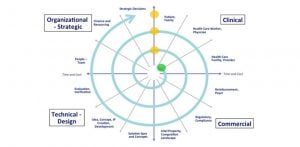Our Spiral Innovation Model Takes an Iterative Approach to Healthcare Innovation
 The basic goal of the one-year MSE program at Johns Hopkins University’s Center for Bioengineering Innovation and Design (CBID) is to bring together individuals interested in biodesign and healthcare technology to develop new, innovative medical devices that solve some of the major challenges facing people around the globe. From people right here in the United States to communities in Kenya, Tanzania, and Nepal, our students work to identify the issues patients and healthcare providers are facing that can be solved using a new piece of medical technology. In order to make this happen, they utilize the Spiral Innovation Model that was created by our team here at the CBID.
The basic goal of the one-year MSE program at Johns Hopkins University’s Center for Bioengineering Innovation and Design (CBID) is to bring together individuals interested in biodesign and healthcare technology to develop new, innovative medical devices that solve some of the major challenges facing people around the globe. From people right here in the United States to communities in Kenya, Tanzania, and Nepal, our students work to identify the issues patients and healthcare providers are facing that can be solved using a new piece of medical technology. In order to make this happen, they utilize the Spiral Innovation Model that was created by our team here at the CBID.
About the Spiral Innovation Model
Through our research, we learned that the traditional model for healthcare innovation follows a “bench to bedside” approach, in which all the research and development is conducted in a lab before being tested on patients. In a large majority of cases, however, this approach presents many challenges, like not offering a useful solution to a problem. Instead, taking an iterative approach – that is, repeating a process over and over again – is the better method that leads to more focused research and valuable technology.
The CBID Spiral Innovation Model follows this iterative approach and involves four main themes:
- Clinical – Students will study with and learn the perspectives of healthcare workers. They will immerse themselves in medical environments to identify the issues facing patients and healthcare workers today.
- Commercial – Students will explore the true value of the medical device. It means looking at any regulatory or compliance issues that could arise, as well as researching the competitive landscape and understanding the device’s intellectual property.
- Technical – The technical development of a prototype begins. Students take the information they’ve gleaned during the clinical and commercial phases to begin creating their product and evaluating its performance.
- Organizational – Students take the time to discuss the additional challenges that could affect the success of their medical device, such as financing the project, organizing additional resources that may be needed, managing a team, and more.
Implementing an Iterative Approach
Students in the CBID program start their project with clinical immersions, needs finding, and opportunity assessments. This allows them to only move forward with their initial idea if it appears viable after spending time in a clinical setting and talking with patients and healthcare providers. It’s about truly understanding the needs of patients and providers to develop a solution that will help them. After this research phase, if it appears that the initial idea is not viable, the student can pivot to a new idea or alter their design to better fit the needs of patients.
An iterative approach takes into account the idea that nobody can truly assume they understand everything about an unmet need in full detail. Being in the medical field means constantly evolving to meet the changing needs of patients, providers, and the healthcare system at large. Every student in the CBID program goes through our Spiral Innovation Model multiple times to gain a better understanding of their medical device and the issue they are trying to solve. This way, they can be sure that their medical device addresses all key factors involved in healthcare: from patients to regulatory bodies to resourcing and more.
While there are many ways to perform healthcare research and medical device engineering, an iterative approach using CBID’s Spiral Innovation Model is the best way to ensure that all aspects of an innovation process are carefully looked at. The medical device that is unveiled at the end of the process is one that has been thoroughly researched and vetted and will provide a lasting impact for patients.


